

“We Mean Business”: Reparations Supporters Return to State Capitol for Day of Advocacy
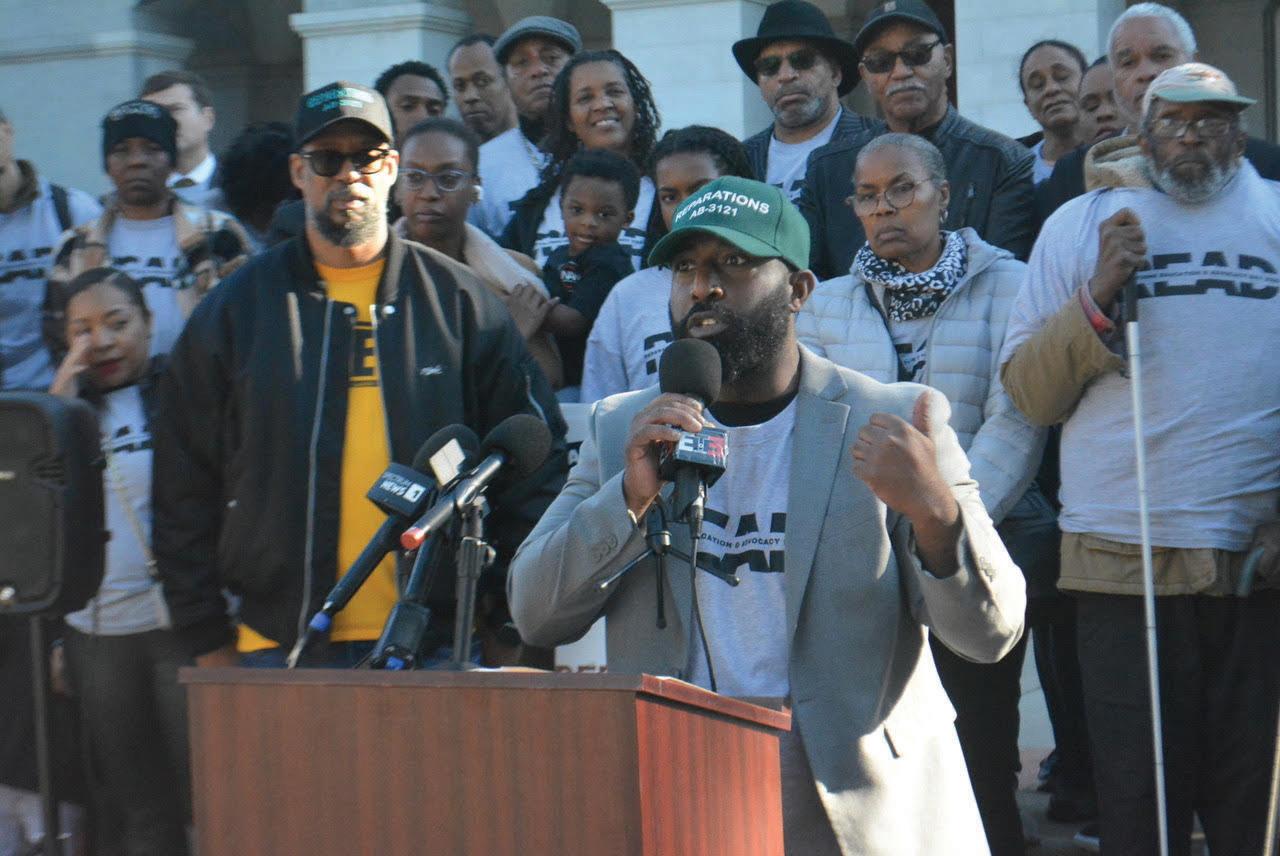
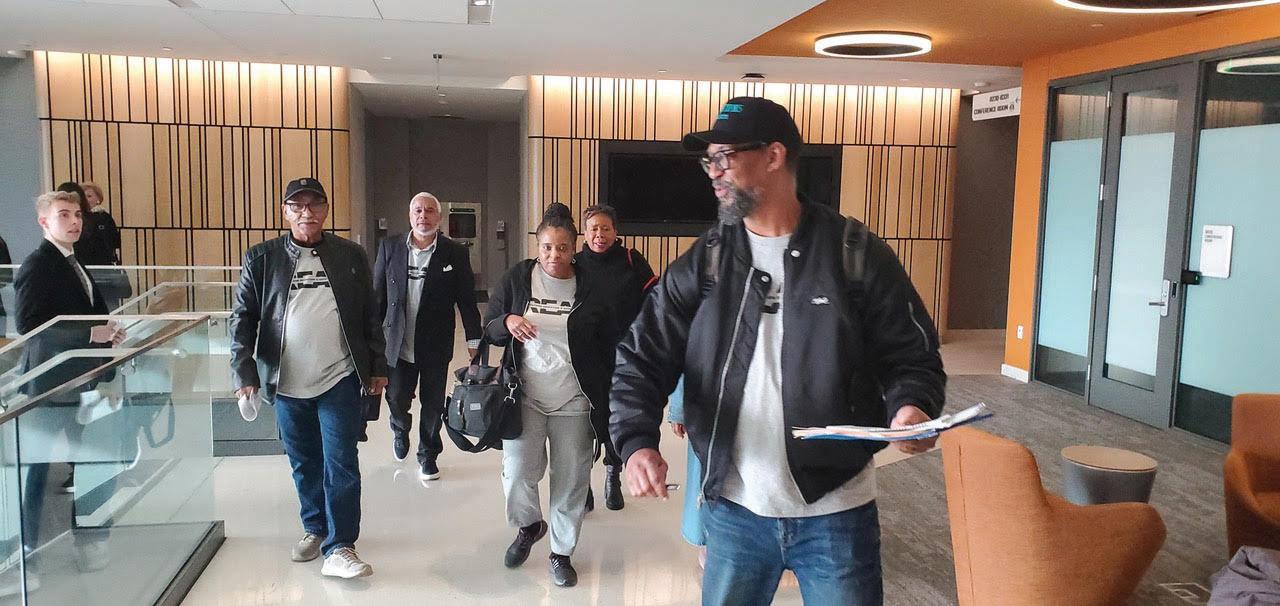
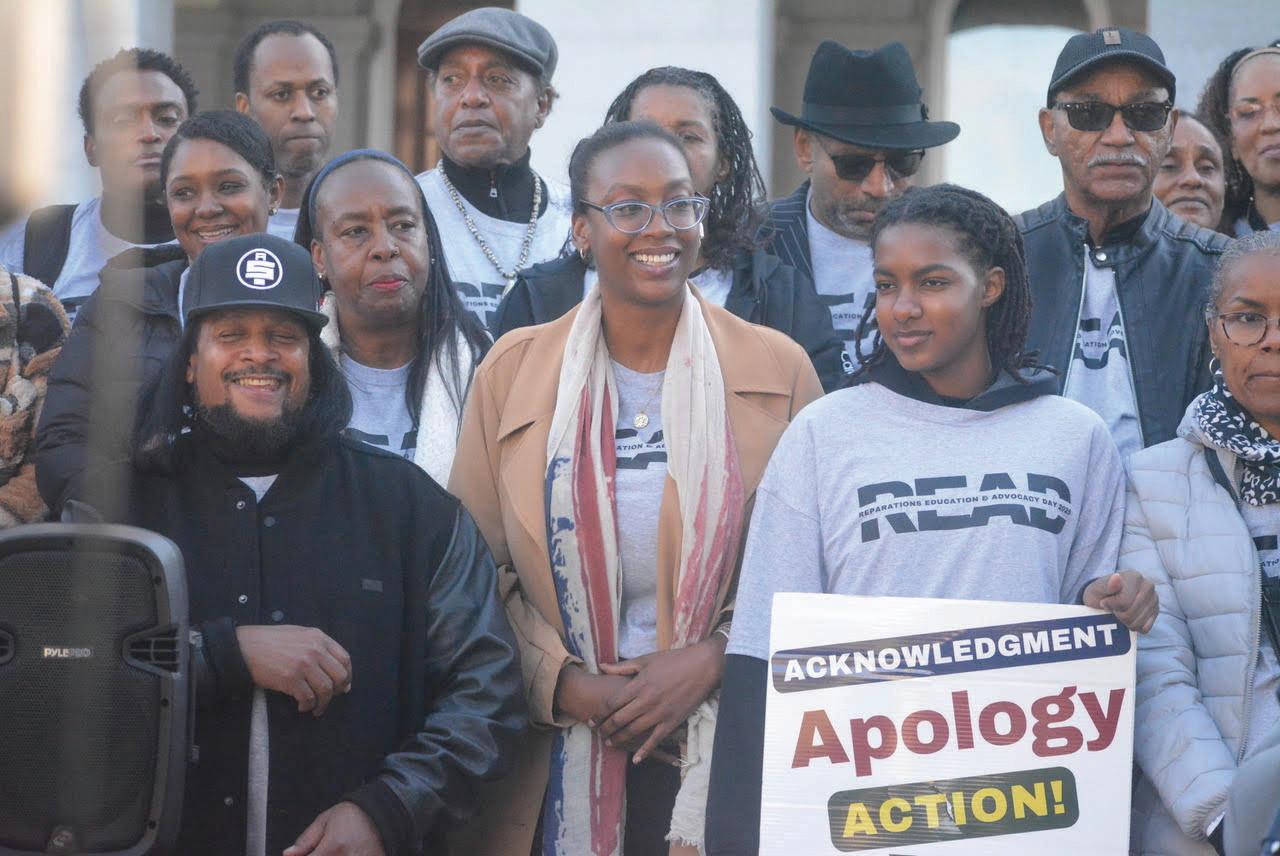
with a message and a mission to educate others that they will not be deterred in their efforts to reintroduce the reparations bills in the Legislature this year.
(AB) 3121, from May 2021 to June 2023. Moore told California Black Media (CBM), “This day speaks to the resiliency of descendants of American slaves. We are not taking no for an answer. We came right back once the doors opened to the capitol. We came back and we mean business.” This time, the advocates say, they returned to Sacramento
CJEC is California’s statewide leading grassroots of advocates, organizers, and mobilizers for reparations and reparative Justice. They have been meeting privately after two bills Authored by former Sen. Steven Bradford (D-Inglewood) -- Senate Bill (SB) 1403 and SB 1330 -- stalled in the Assembly. SB 1403 proposed the creation of a new state agency called the California American Freedmen
Affairs Agency (CAFAA). It would’ve been accountable for determining eligibility for reparations and administering government processes related to compensation.
SB 1331 was designed to build an account for reparations in the State Treasury for the purpose of funding reparations policies approved by the Legislature and the Governor.
Chris Lodgson, leader of CJEC, and other advocates visited the offices of almost the entire body of120 State Senators and Assemblymembers, urging them to introduce or support 2025 Reparations bills. The group spent the day knocking on the doors of the lawmakers housed in the State Capitol Annex Swing Space.
Marcus Champion, a Los Angeles community activist, photojournalist, and reparations advocate made the trek from Southern California to Sacramento. He shared his impression of the roles of the lawmakers, particularly members of CLBC.
During the last legislative session, leaders of the CLBC cited that they had “structural” concerns about the reparation bills. Therefore, they voted against advancing the legislation for a floor vote by their colleagues.
The advocates say they expect to bring the bills back under a new leadership that includes CLBC chairperson Sen. Akilah Weber-Pierson (D-La Mesa) and vice chair Issac Bryan (D-Ladera Heights).
“It was a good day to send a message to the folks inside that we are here for business,” said Champion. As we have mentioned several times, Aug. 31 was unacceptable. We’re going to make sure that doesn’t happen again.”
Champion continued, “The legislators in there are supposed to represent us and if they can’t get the job done, we will find folks who can.”
Advocates say the reparations bills they support are proposing a state agency to verify lineagebased reparations eligibility; a reparations fund in the state Treasury; and funding for reparations activities in the 2025 Budget, including direct cash payments to qualifying Black Californians and restitution and compensation for stolen property.
Lodgson said that they are prepared to have discussions with the CLBC, Republicans, and Democrats as a whole to form a consensus to support the bills.
Lodgson and others who support reparations for Black Californians based on lineage say that they are willing to
“We Mean Business”: Reparations Supporters Return to State Capitol for Day of Advocacy... continued
discuss their goals with other factions of reparation supporters who advocate for compensation to be based on race.
If approved, lineage-based reparations would be limited to Black Californians who can trace their ancestry back to enslaved or free Black people in the United States before 1900.
Race-based reparations would open up the eligibility pool for reparations to include anyone in California who identifies as Black as opposed to Californians
with a direct connection to a person who was enslaved in the United States.
“Our specific work and our specific focus is on those of us whose ancestors were enslaved and emancipated in this country,” Lodgson told CBM. “We are willing to work with anybody who supports that, but we are not moving off that square. We are our own people. No one has done what we’ve done for this country.”

The long struggle to establish Martin Luther King Jr. Day
by TERRY TANG Associated Press
The Rev. Martin Luther King Jr. gave his iconic “I Have a Dream” speech in 1963 on the steps of the Lincoln Memorial. He chose that location in part to honor President Abraham Lincoln as “a great American, in whose symbolic shadow we stand today.” Now, millions of people honor King in the same way.
On the third Monday of January — close to King’s Jan. 15 birthday — federal, state and local governments, institutions and various industries recognize Martin Luther King Jr. Day.
For some, the holiday is just that — time off from work or school. But, King’s family and others carrying on his legacy of equality, justice and nonviolent protest want Americans to remember that this holiday is really about helping others. While it is now a time-honored tradition, the establishment of the holiday had a prolonged, difficult path to acceptance.
How the idea for MLK day began
The idea to establish a national holiday for the civil rights icon arose as the nation was plunged into grief. U.S. Democratic Rep. John Conyers of Michigan, one of the longestserving members of Congress
known for his liberal stance on civil rights, proposed legislation to recognize King four days after his assassination outside a motel in Memphis, Tennessee, on April 4, 1968.
Supporters knew it would not be easy. King, who was 39 years old at the time, was a polarizing figure to half the country even before his death, said Lerone Martin, director of the Martin Luther King, Jr. Research and Education Institute at Stanford University. Polls conducted by the Washington Post and the New York Times indicated most Americans did not trust King or thought he was too radical because of his speeches on poverty, housing and against the Vietnam War.
“People say that King is moving too fast after 1965 and basically ‘Hey, you got the Voting Rights bill done. That’s enough,’” Martin said.
The Congressional Black Caucus, founded by Conyers, tried to bring the legislation up for a vote for the next 15 years. Among the Republican rebuttals — public holidays don’t apply to private citizens, King was a communist or King was a womanizer. In the meantime, his widow, Coretta Scott King, kept lobbying for it. Musician
Chad Brown leads a group visiting lawmakers' offices at the State Capitol Annex Swing Space to garner support for reparations legislation. Jan. 7. CBM photo by Antonio Ray Harvey.
Chris Lodgson, an organizer for CJEC, addresses supporters in front of the California State Capitol, reaffirming their commitment to pursuing reparative justice. CBM photo by Antonio Ray Harvey.
Los Angeles-based attorney Kamilah Moore, Esq., center, joined other supporters of reparations at the State Capitol for Reparations Advocacy Day on Jan. 7. CBM photo by Antonio Ray Harvey.
Thursday, January 23, 2025
President Biden
awards STEM NOLA the Presidential Award for Excellence In Science, Mathematics and Engineering Mentoring

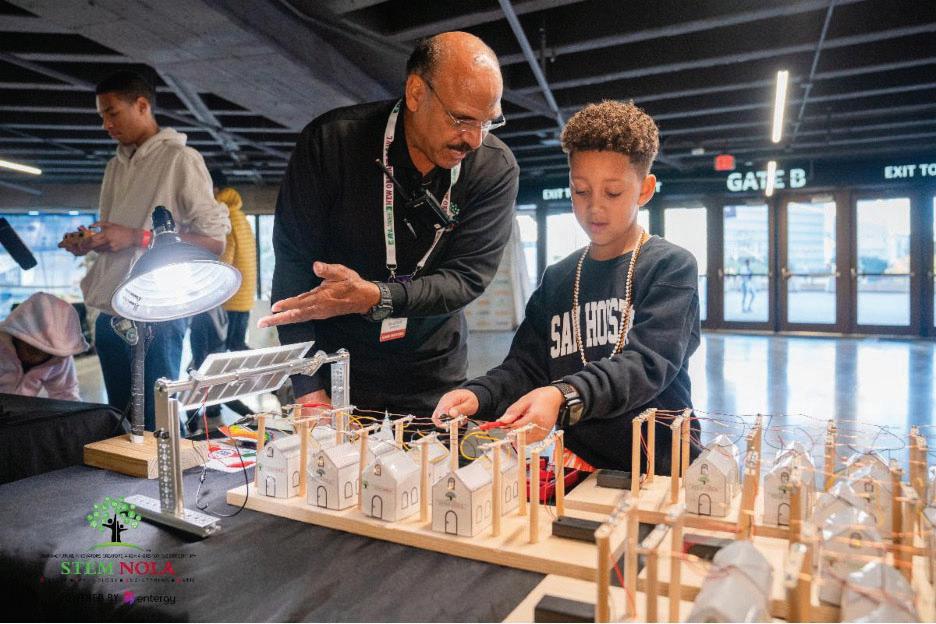
President Joe Biden has awarded STEM NOLA the prestigious Presidential Award for Excellence in Science, Mathematics, and Engineering Mentoring (PAESMEM). The New Orleans-based non-profit is a national leader in breaking down racial, ethnic, and gender barriers in teaching Science, Technology, Engineering, and Mathematics (STEM) to K-12 students.
The PAESMEM is the nation's highest honor for mentors who work with underrepresented groups to develop fully the Nation's human resources in STEM. “These awards honor the vital role that America’s teachers and mentors play in shaping the next generation of technical leaders, including scientists, engineers, explorers, and innovators,” said the presidential message announcing the awards.
STEM NOLA is celebrated for its exceptional impact on the future of STEM education and workforce development. The award includes a $10,000 prize.
“Receiving the Presidential Award is a monumental honor for STEM NOLA,” said Dr. Calvin Mackie, President, co-founder and CEO of STEM NOLA.
“The award highlights the incredible power of mentoring in unlocking the untapped potential of students from all socioeconomic backgrounds to learn STEM. Our work is rooted in the communities we serve. Mentoring is at the core of realizing success in STEM for historically underrepresented students.”
“This recognition boosts our morale and inspires us to continue our mission with even greater determination,” Dr. Mackie said. “At STEM NOLA, we focus on providing high-quality, hands-on STEM experiences and mentorship opportunities that open doors for young people—especially those from underserved communities. This award affirms our belief that every student, regardless of race or background, deserves the opportunity to succeed in STEM, and it recognizes the power of mentoring in making that vision a reality.”
STEM NOLA was founded in 2013 when Dr. Mackie’s sons, Myles and Mason, complained that they weren’t interested in science anymore because their grade school teachers didn’t engage them enough. Dr.
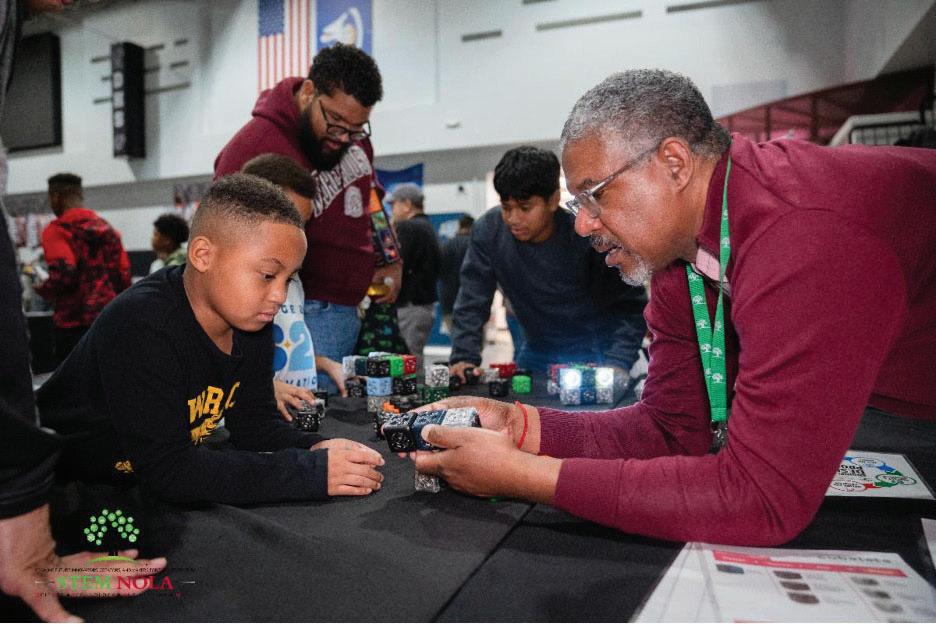
saying the award is a testament to their dedication and commitment.
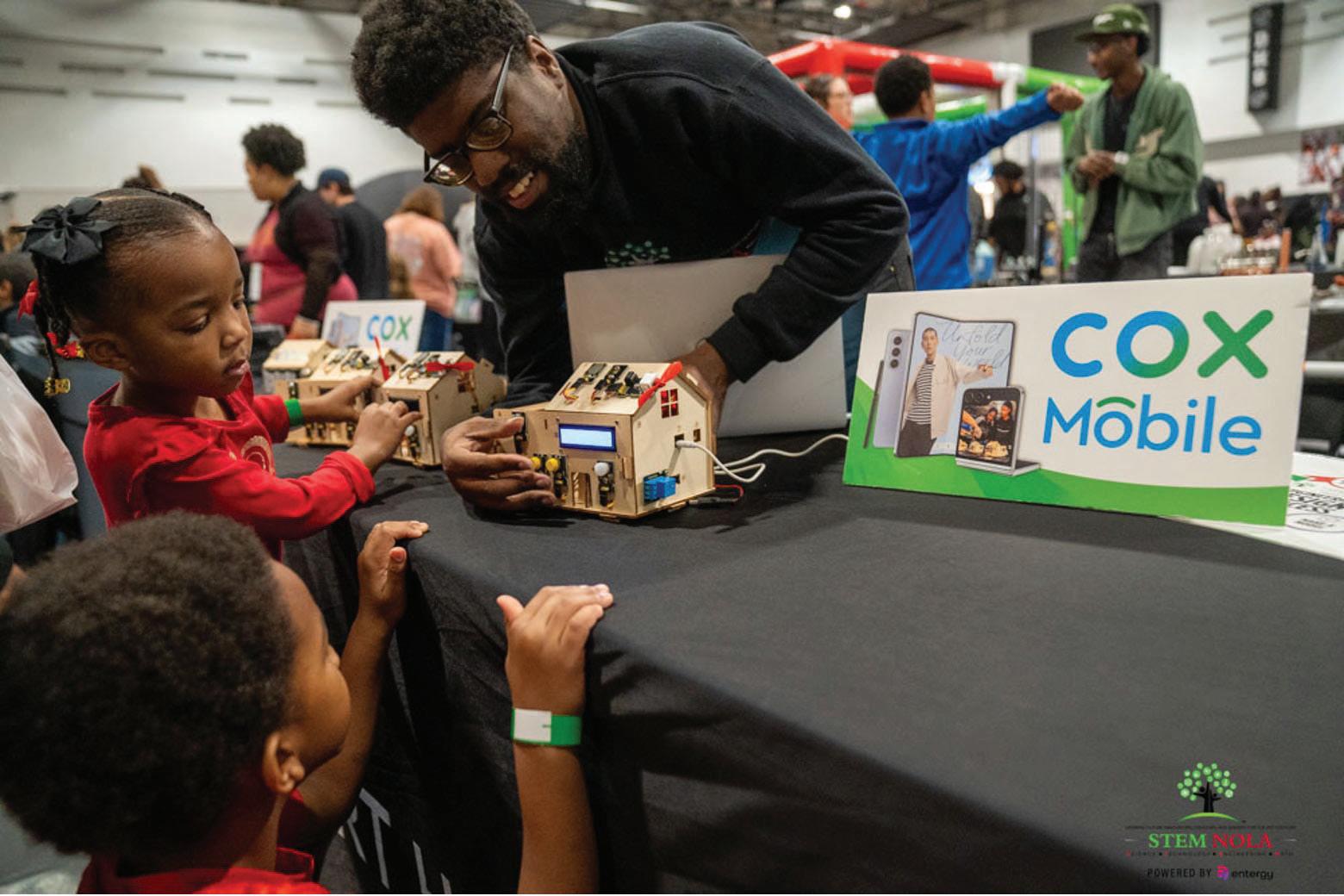
Mackie was disheartened; he wanted his sons to enjoy science and engineering as he did. He took his sons to the garage on weekends, where they did science experiments and handson adventures that reignited their interest. Neighborhood kids began joining them in the garage, with the group growing to more than 20 each weekend.
“That’s where STEM NOLA was born,” said Dr. Mackie, a former tenured engineering professor at Tulane University. He holds a Bachelor of Science in Mathematics from Morehouse College and a Bachelor’s, Master’s, and Ph.D. in Mechanical Engineering from Georgia Tech.
Dr. Mackie and his wife, Tracy, seeded STEM NOLA with $100,000 of their savings. Dr. Mackie pleaded his case to local corporations, philanthropic organizations, and government officials and won their support. Entergy Corporation, the power company, and Chevron Gulf of Mexico Business Unit became their prime sponsors. He recruited churches and community centers
“We are deeply grateful to all our supporters, whose belief in our mission has been instrumental in our success,” Dr. Mackie said.
In 2021, Dr. Mackie launched STEM Global Action (SGA), a network of affiliates, like STEM NOLA, in locations nationwide.
In 2024 alone, SGA engaged over 40,961 participants across 14 U.S. states, reaching students through events such as STEM Fests, STEM Saturdays, Tech Camps, and STEM Fellows programs. Since its founding, SGA has touched the lives of more than 200,000 students and has worked with over 2,500 college student volunteers and 1,500 professional mentors. This vast support network has provided students with hands-on experiences that have sparked curiosity, critical thinking, and a desire to pursue high-wage, high-growth careers in STEM fields like technology, healthcare, and engineering.
Ethnic Minorities Face Rising Hate Crimes in Rural California
By Selen Ozturk
Hate crimes are mounting in rural California, where many ethnic minorities are too distrustful of the government toreport them.

Hate crimes are mounting in rural California, where many ethnic minorities are too distrustful of the government to report them.
In response to this rise, California launched CA vs Hate, a reporting and resource hotline for those facing hate to find support in the form they want. Since the initiative’s May 2023 launch, “For the first time in California history, we’ve had a statewide hotline to help people targeted for hate report it and identify options for next steps,” said Kevin Kish, director of the state Civil Rights Department, at a Friday, January 17 Ethnic Media Services briefing on the hotline and hate in rural California.
“This is not just a hotline where people tell the government what happened to them. It’s a tool to connect people who experience hate with culturally competent resources they need, in the communities where they live.”
This includes legal services; law enforcement referrals; counseling and mental health resources; financial aid; and connections to community organizations like health clinics or social service agencies.
Kevin Kish, Director of the CA Civil Rights Department, shares the contact information for California Versus Hate and discusses some of the reporting resources available. Responding to hate
Federal data shows that race-, ethnicity- and ancestry-motivated hate crimes in California rose from 49 in 2021 to 1,367 in 2022 — a 2,690% increase.
Although crimes dipped slightly to 1,108 in 2023, the most recent year with full data released, a 52.4% majority of all reported hate crimes overall were motivated by race, ethnicity and ancestry; other motivations include sexual orientation (21.9%), religion (20.5%), gender identity (3.8%), disability (1.1%) and gender (0.3%).
A federal Department of Justice study conducted between 2011 and 2015 shows that 54% of hate crimes nationwide are not reported to police.
“The communities who most face hate are often most underrepresented because they’re afraid of reporting to law enforcement,” said Kish. “Some have reported and nothing happens, so they don’t see the point. Many don’t know if what happened to them is legally a crime that they should report. For immigrant communities in particular, there may be language barriers and fear related to contacting the government. People in indigenous communities may be grappling with jurisdictional issues between tribal and local, state and federal authorities.
Ethnic Minorities Face Rising Hate Crimes in Rural California...continued
In rural El Dorado county northeast of Sacramento, where 74% of the population is non-Hispanic White and 2% is Native American, “There’s an epidemic of hate. It’s very conservative here,” said Kim Stoll, communications director for the Shingle Springs Band of Miwok Indians.
“For instance, we were having tags made for our cars in the parking lot, but many tribal members said ‘No, we’re not going to do that. If we identify ourselves as tribal members, there’ll be a problem,’” said Stoll. “It was interesting to see that, knowing how long they’ve been here on the reservation … yet how isolated they remain.”
Gaonou Vang, Communications and Narrative Manager, at Hmong Innovating Politics (HIP), discusses the deportation threats faced by the Hmong immigrant community.
Gaonou Vang, communications and narrative manager at Hmong Innovating Politics in Sacramento, attested to similar isolation in the Hmong community, of which are an estimated 95,000 to 107,458 in California and 368,609 in the U.S.
“There’s not enough trust that has been built with our communities … ever since the first generation of Hmong refugees from the Vietnam War and the Secret War in Laos in the ’60s,” she explained.
“Many Hmong are naturalized citizens due to former refugee statuses, or being born in America, but we have a rising demographic of green card holders in the last decade, and a rough estimate of 4,500 of these folks have orders against them to be deported as a result of being convicted in a crime, whether it be small or large … even after they serve their time and have been released,” Vang continued.
With rising ICE raids of Southeast Asian communities; repatriation agreements with Cambodia and Vietnam; and the incoming Trump administration having issued final orders for removal of Hmong to Laos its last time around in 2020, “concern is rising while trust in the government falls, so there’s a lot of underreporting overall,” she said.
In response, “It’s been very important for us to empower our youth as community leaders,
Kim Stoll, Marketing and Communications Director of The Shingle Springs Band of Miwok Indians, discusses El Dorado County’s growing acceptance for educational programs that teach how events like the Gold Rush impacted the indigenous communities who originally lived in the region.
“This hotline was designed to overcome these barriers,” he added. “People aren’t necessarily looking for this information until it happens to them, and when it does, they need to access it wherever they are.”
Californians can report online at cavshate.org, or talk to a civil rights agent by phone at (833) 866-4281 or 833-8-NO-HATE, Monday to Friday from 9 a.m. to 6 p.m.
Free support is available in 200 languages and anonymous reporting is available.
In the hotline’s first year, it received over 1,000 hate reports from nearly 80% of the state’s counties, and roughly two-thirds of people who reported hate agreed to follow up for resources and support referral.
However, all counties which reported no or very few hate crimes were rural counties like Del Norte, Sutter and Mariposa.
Hate in rural California
because we see this domino effect: When we educate them, they educate their families, and it trickles into the community,” Vang added. “With CA vs Hate, a lot of the work we’ve been doing is showing youth how to overcome that distrust and report this hate that’s happening in our communities.”
Marlene Thomas, Executive Director of the Imperial Valley Social Justice Committee, discusses hate in Imperial County and the limited knowledge and information people have about their ability to report hate crimes and incidents.
“Hate is everywhere. What makes it stand out here is that the population has made a major shift,” said Marlene Thomas, executive director of the Imperial Valley Social Justice Committee, a nonprofit in Imperial County, one of the two California counties bordering Mexico.
“When I was growing up, this was primarily a white community, and now it’s 90% Hispanic,” she explained. “But the difference is, there’s been an assimilation of the older Hispanic community, while newer immigrants just trying to survive are being discriminated against, really by their own people.”
In November 2023, six months after the launch of CA vs Hate, “We had a Stop the Hate conference, and the local chief of police and the sheriff were there and went through the reporting process that you have to do. But they had only two complaints,” Thomas continued. “I know that there had to have been more than that, but there wasn’t … Why this fear, this lack of awareness of what people can do?”
“Our committee initially came together in 2022, in response to police harassment in our county, particularly with the African American community. Now, we have over 7078 volunteers,” she said. “We work closely with the ACLU and give workshops about your rights and what to do when stopped by the police or Border Patrol.”
Thanks to this hotline, “One of the first things we can do is bring this information about reporting hate to our schools and community institutions,” Thomas added. “But it’s not enough … When you’re facing hate, at heart, it’s about keeping hope alive.”

Dr. Mackie congratulated his employees, partners, and volunteers,
as teaching facilities. STEM NOLA soon became the model for bringing STEM learning to under-resourced communities.
What Will a Second Trump Presidency Mean for LGBTQ+ Civil Rights?
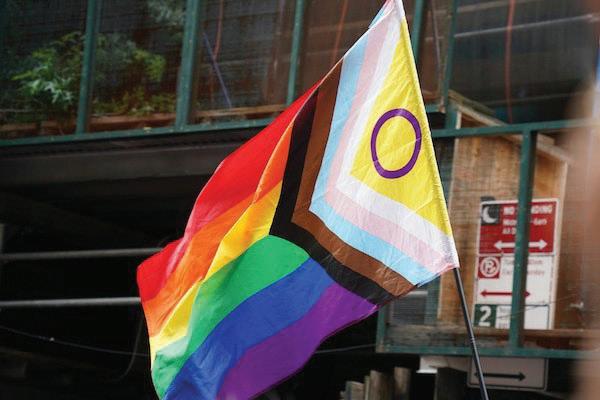
LGBTQ+ advocates didn’t even have to wait until President Trump’s first day in office to see how an emboldened Republicancontrolled Congress will act.
On January 14, days before the inauguration, the U.S. House passed the “Protection of Women and Girls in Sports Act,” prohibiting transgender women and girls from playing on school sports teams that align with their gender identity; companion legislation has also been introduced in the Senate. “This is obviously concerning,” said Emma Chinn, communications and policy manager at the Campaign for Southern Equality, an LGBTQ+ advocacy organization focused on the Southern states. “Here in the South we’ve been dealing with anti-LGBT and especially antitrans policies at the state level for a while, and we’re definitely concerned now that some of those policies, like restrictions on gender-affirming care and threats to marriage equality, are going to be replicated at the federal level. And we’re concerned about the bad policies we have in a lot of our Southern states actually getting worse.”
Some state legislatures that had previously passed sports bans,
for example, have expanded the reach of the bans to other age groups, or to include trans boys, explained Chinn. The Campaign for Southern Equality’s Trans Youth Emergency Project offers funding to youth and families in every state that bans genderaffirming care to travel out of state for care, so the possibility of additional states passing such bans is also of great concern. And states that have banned genderaffirming surgery, or a specific type of surgery, might now move to include hormone replacement therapy and puberty-delaying medication in those bans. Federal funding for gender-affirming care could also be under threat, and there could be attacks on public hospitals providing this care.
Already LGBTQ+ advocates have been fighting back against an onslaught of anti-LGBTQ+ bills in state legislatures that has “been happening at an increasing volume over more than ten years now,” said Jennifer C. Pizer, chief legal officer at Lambda Legal. Last year, close to 600 of these bills were introduced, a large percentage targeting transgender people. And while only 8% of the bills were actually signed into law, advocates are hardly celebrating.
“In one way, it sounds encouraging that 90% failed, but the trouble is the absolute number has been increasing exponentially,” said Shannon Minter, legal director of the National Center for Lesbian Rights. “So 10% of what is now
Fire Prevention and Resilience in California: A Policy Blueprint for Government Leaders
The devastating fires in Los Angeles County underscore the urgent need for proactive measures to reduce wildfire risk and improve community resilience in California. While no preparation can entirely prevent tragedies when 100 MPH winds ignite urban canyons, there are practical steps local and regional leaders can take to better prepare for the next wildfire.
Local elected officials can play a critical role in reshaping state policies and overcoming bureaucratic obstacles that have long hindered California’s wildfire preparedness. Working collectively, local authorities can marshal the political, financial, and legal resources needed to dismantle the thicket of counterproductive laws, regulations, and bureaucracy that have undermined California’s ability to prepare for fires, and pave the way for more effective fire prevention strategies.
This moment calls for a candid assessment of the policies that have exacerbated wildfire risk. Despite good intentions, environmentalist-inspired regulations have contributed to water and energy scarcity, reducing our ability to fight fires effectively. These same policies have also limited responsible forest management and the proactive clearing of brush from urban canyons — practices essential for wildfire resilience.
The recommendations below provide a roadmap for enhancing fire prevention and readiness across California, empowering leaders to protect their communities from future disasters.
1 – Support legislation that streamlines the approval process for projects that deliver more water, and repeal legislation that deters investment in more water
Fire Prevention and Resilience in California: A Policy Blueprint for Government Leaders...continued for it.
5
– Revise building codes to improve the many standards that already exist to protect homes against wildfires. Eliminate combustible exteriors, install windows with tempered glass, and require fire-resistive roof underlayment, non-combustible fences and decks, closed attics, or attics with ember-resistant vents that are sprayed with fire retardant interior coating.
6 – Encourage private residential pool construction with the condition that they include, as this well-prepared homeowner suggests, “a 3–inch suction line in the deep end with a standpipe at the street to allow firefighters a guaranteed source of water.”
7 – Embrace the concept of resilience instead of retreat. At 4,790 per square mile, California has the highest urban density in the United States while only 5 percent of California’s land is urbanized. Fire risk in the urbanwildland-interface should inspire us to prevent fires or withstand fires in these areas, not force Californians into increasingly dense urban cores.
8 – Resist the regulatory assault on permeable surfaces that both percolate runoff, transpirate valuable moisture into the atmosphere, and reduce urban heat island impact. For example, tear up artificial turf and replant grass on athletic fields. Instead of forcing homeowners to abandon lawns, simply ban use of pesticides and herbicides on lawns. We are not taking advantage of the potential for well-hydrated urban landscapes to increase humidity and resist ignition.
9 – Work with Explorer Scout troops, homeless services, county corrections officials, community colleges, local
infrastructure. In particular, state legislators should either repeal the California Environmental Quality Act (CEQA) altogether, or at the least, take away the right of third-party private attorneys to file lawsuits pursuant to CEQA, which often will delay, if not stop, badly needed fire prevention strategies including brush removal, prescribed burns, and grazing.
2 – Repeal Senate Bill 1157 and related legislation that enforces permanent water rationing on California’s households and businesses. This intrusive law will squander an estimated $7 billion to save a scant 440,000 acre feet of water per year. But its ultimate impact will be to slow, if not stop, efforts by urban water districts to increase their supply capacity. Under countless disaster scenarios for which we may have no advance notice, stripping all surplus out of our capacity to store, treat, and distribute water can have devastating consequences.
3 – Work with local fire department officials to identify fire-prone neighborhoods and adjacent open space and send crews annually to clear overgrown fuel. The procedures to do this are well established; we just haven’t done enough of it. Fast track the approval process (hours, not months) for applications to perform the work. Then use all available tools and techniques to reduce overgrown vegetation — goats and other grazing animals, prescribed burns, and mechanical thinning.
4 – Bury power lines. All of them. Everywhere. Secure state and federal funds to help pay
fire departments and other community organizations to recruit and train a firefighting reserve corps. Drawing on wellestablished criteria for training volunteer fire brigades, but scaled up, create an army of firefighting reservists that undergo annual refresher training and are on call whenever disaster strikes.
10 – Reimagine firefighting and fire prevention to save money and improve results. Work with private and public fire agencies and private entrepreneurs to procure and test not only systems to remotely detect small fires before they become big fires, but also nextgeneration technologies such as water carrying, firefighting drones and autonomous robots designed to march into canyons to cut and remove brush. There is no reason why small cities and agencies cannot have someone looking into these opportunities and make small investments. Accelerating the development of these innovations may be the final decisive step necessary to make the experience of cataclysmic wildfires recede into history.
The scale of the ongoing tragedy in Los Angeles County defies description. But it doesn’t have to happen again. With decisive action and smart policies, California leaders can reduce wildfire risks, protect communities, and prevent future disasters.
by Edward Ring, Director of Water and Energy Policy at California Policy Center. Ring is the co-author, along with Steve Hilton, of Modern Forest Management (March 15, 2024), a report from Golden Together that is essential reading on the mismanagement of California’s forests that includes additional recommendations for state and federal reforms that should be enacted to advance effective wildfire prevention.
The long struggle to establish Martin Luther King Jr. Day...continued from page 1
Stevie Wonder even released a song, “Happy Birthday,” to rally support.
So, what changed?
By the 1980s, the social and cultural climate in the U.S. had shifted and the public was reflecting on racial progress, Martin said. Most Americans now were also regretting the Vietnam War. Supporters, meanwhile, were still calling for federal holiday status.
In 1983, about 20 years after King’s “I Have a Dream” speech, legislation for a Martin Luther King Jr. Day on the third Monday of January cleared Congress and President Ronald Reagan signed it.
States held back as activists stepped up
Reagan’s signing did not lead other Republicans to follow. It would be 17 more years until all 50 states observed it. Most of the foot-dragging came from the South — except for Arizona. Then in 1987, Gov. Evan Mecham rescinded his predecessor’s executive order enacting a state holiday in Arizona.
“He said ‘Black people don’t need a holiday. Y’all need jobs,’” recalled Dr. Warren H. Stewart Sr., senior pastor at First Institutional Baptist Church in Phoenix. “That started the war.”
Stewart launched a group to lead “people of all colors and all persuasions, faiths and parties” in protest marches. Entertainers including Wonder canceled Arizona events. Companies moved conventions. The tipping point was the loss of hosting the Super Bowl. In 1992, Arizona became the first state where voter
What Will a Second Trump Presidency Mean for LGBTQ+ Civil Rights?...continued
a very large number passing has been catastrophic for people living in more conservative states, and specifically, it has been catastrophic for transgender young people. We have to be realistic and acknowledge that this is a severe backlash and that a part of our community— transgender young people in particular—are suffering very severe harms at the moment.”
Advocates are worried about what will happen to transgender people, especially transgender youth, over the next four years.
In a study published last year, the Trevor Project found that state-level anti-transgender
laws increased suicide attempts by up to 72% in transgender and nonbinary youth. “These are lives that hang in the balance, and we really need to come together to support trans youth and we need people to speak up, if they can, because this is so critical,” said Meg York, director of LGBTQ+ family law and policy and senior policy counsel at Family Equality, which advocates for LGBTQ+ families.
Right-wing politicians have been deliberately introducing as many bills in state legislatures as they possibly can, without any regard for overlap with
The long struggle to establish Martin Luther King Jr. Day...continued
have been hundreds of projects involving hundreds of thousands of people for MLK day in recent years. Engagement seems to be expanding.
“You know, any given day I see another project that has nothing to do with us,” said Smith, who has served in President Joe Biden’s administration. “What’s so important about the King holiday is not only the service that’s going to happen, but how it creates a spark for people to think about how maybe they’re going to serve all year long.”
That’s something King’s daughter, the Rev. Bernice King and CEO of the King Center in Atlanta, desires as well.
She wishes people would do more than “quote King, which we love to do.” They need to do good work and commit daily “to embrace the spirit of nonviolence.” Martin also thinks it’s important to learn about the man himself. He finds excitement in seeing people read or hear about the Nobel Peace Prize winner. But, nothing compares to taking in King’s own writings such as his 1963 “Letter from the Birmingham Jail,” he added. “We can arm ourselves with his ideals,” Martin said. “We can continue to have a conversation with him — not just on one day but actually throughout the year.”
initiative reinstated the King holiday.
Supporters took a victory lap the next MLK Day with a packed arena concert attended by Wonder and other artists. Even Rosa Parks was there. Stewart remembers speaking to the crowd.
“What I said there — and it still applies today — we’ve won the holiday but the holiday is a symbol of liberty and justice for all and we must move from symbol to substance,” he said.
South Carolina was the final holdout until 2000. But, it was without the backing of the civil rights groups because it also allowed for a Confederate Memorial Day.
A ‘day on, not a day off’
Martin Luther King Jr. Day’s reach has only grown in its 42 years.
It’s the only federal holiday where you take a “day on, not a day off.” In 1994, President Bill Clinton signed into law Congressman John Lewis and Sen. Harris Wofford’s legislation making it a National Day of Service.
Just about every major city and suburb has some revelry the weekend before, including parades, street festivals and concerts. The various service projects run the gamut — community clean-up, packing food boxes, donating blood.
AmeriCorps, the federal agency that deploys volunteers to serve communities around the nation, has distributed $1.5 million in grants to 200 nonprofits, faith-based groups and other organizations for projects.
CEO Michael Smith estimates there
Press Statement from Enough Is Enough Regarding TikTok Supreme Court Decision
Parents Beware: Valid National Security Concerns and TikTok’s U.S. Toxic Version Pushed to America’s Children Make it a Double Threat
Washington, D.C. - Enough Is Enough applauds the Supreme Court’s unanimous ruling upholding a federal law that could ban TikTok unless its Chinese-owned company, ByteDance, sells its U.S. operations by January 19, 2025. In his concurring opinion, Justice Gorsuch noted that the law serves a compelling interest; preventing a foreign country, designated by Congress and the President as an adversary of our Nation, from harvesting vast troves of personal information about tens of millions of Americans.
An equally concerning issue about the TikTok, which has 170 million U.S. users, is the stark contrast between the Chinese and the U.S. version of the popular platform. While the Supreme Court's decision centered on national security risks posed by its ties to China, American parents should be aware that ByteDance's domestic Chinese version, Douyin, enforces strict protections for young users and carefully curated educational content - protections notably absent from the U.S. version of TikTok.
The TikTok algorithm served to U.S. children is vastly different and can expose them to harmful content promoting dangerous behaviors, inappropriate material, and addictive viewing patterns. Recent demonstrations show that a new account registered as a 15-year-old American girl immediately receives recommendations for
dating older men, substance use, and self-harm content -- before the user has even watched their first video. Meanwhile, Chinese youth using Douyin are allegedly served up a much tamer version showing science experiments, educational content, and videos celebrating academic achievement, with mandatory breaks and usage restrictions featuring a “teenage mode” which limits use by children under 14 to 40 minutes a day, making the app unavailable to those users between the hours of 10 p.m. and 6 a.m. This deliberate disparity in content moderation and safety features reveals a conscious decision by ByteDance to protect Chinese youth while exposing American children to potentially harmful content, all while hooking consumers through its addictive algorithms and collecting their personal data. The platform continues to generate $2 billion in advertising revenue from users aged 13-17 alone.
As President-elect Trump, policymakers and potential buyers decide the future of TikTok in America, the safety and wellbeing of millions of young users should be considered just as critical as the existing national security implications of the platform. In both regards, ByteDance has demonstrated it is a bad actor, with little or no concern for America or its citizens.
Photo by Tong Su on Unsplash
4
Recent California Wildfires Highlight the Need for Legal Reform
Governor and Legislature Have Unique Opportunity to Help All Californians by Ending the “Hidden Tort Tax”
By Victor Gomez, Executive Director, California Citizens Against Lawsuit Abuse
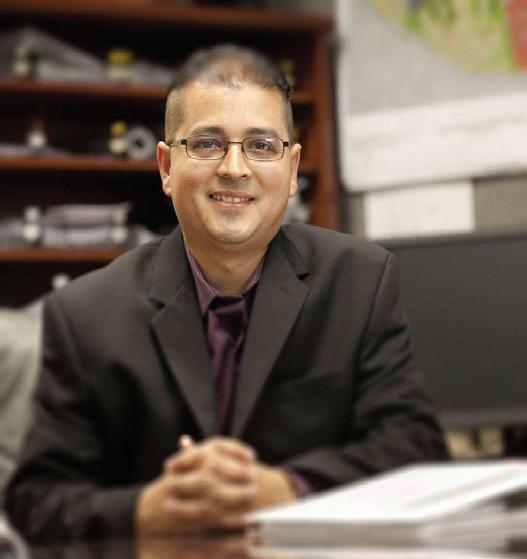
California Governor Gavin Newsom curiously signed an executive order temporarily suspending the crippling California Environmental Quality Act (CEQA), which will now allow victims of the recent fires to more quickly restore their homes and businesses. Interestingly, it’s been no secret that three previous governors have all called for CEQA reform to no avail. Those in the building industry have long known of the abuse of CEQA resulting in long delays which only adds onto the cost of a new home or business.
The law has been twisted to allow the filing of lawsuits where some profit at the expense of others.
CEQA delays can go on for years!
CEQA is a landmark law passed in 1970 and was signed by then Gov. Ronald Reagan. It created an approval system for building projects that essentially slowed any development. The very fact that the Governor is eliminating the delay is an admission that the law is flawed and causes delays and forces costs to go up. Andy Puzder, the onetime CEO of Carl’s Jr., told a meeting of Citizens Against Lawsuit Abuse that,” it’s easier to open a new business in Siberia than it is in Los Angeles, California.”
Perhaps Governor Newsom can take his same pen and offer the same protections to all Californians. CEQA as well as other types of laws that have been abused like the Americans with Disabilities Act (ADA), the
landmark legislation signed into law to ensure the disabled had complete access to public places. Instead, because of the loopholes in the law, a cottage industry was created by trial lawyers who take advantage of it for their own personal gain.
A new report from Citizens Against Lawsuit Abuse shows that Californians pay a hidden “tort tax” of $2,298 for the price of a lawsuit. We all pay the price as jobs are cut and prices go even higher because businesses have nowhere else to turn to get the money they need to settle an unwarranted lawsuit and save their business.
The Governor and legislature could easily fix and put an end to the excessive “lawsuit tax,” which burdens all of us with higher prices on all goods and services.
Business owners from across California tell me about their unwarranted ADA lawsuits. One business owner shared how he received a demand letter about his website from a plaintiff, who said if he paid $1,200 dollars the plaintiff would not file a lawsuit. Only, the website actually tested as being quite compliant. Some people just want to make a buck off of small business owners thinking the business owner will not respond to the demand letter and just send the money. Reforming the legal system such as CEQA and ADA would lead to substantial economic benefits for all Californians. Legal reform removes unnecessary burdens and increases productivity, businesses can invest the money in their business, creating new jobs, expanding everything that enhances a community and creates tax dollars. Instead, last year, a Perryman Group report details excessive tort litigation had a direct cost of $57 billion, the loss in local government
continued on page 6
Los Angeles County Department of Public Health Reaffirms Commitment to Providing Support to All Residents, Regardless of Immigration Status
Public health services remain accessible to everyone, ensuring equitable care and support for vulnerable communities
Health News
The Los Angeles County Department of Public Health is committed to ensuring that all individuals, regardless of immigration status, can access essential public health services. Protecting the health and wellbeing of every resident is central to Public Health’s mission, and immigration status will never be a barrier to receiving services or support.
All public health services will continue to be available, including:
Clinic Services: Comprehensive care provided at public health clinics across the county.
Home-Based Programs: Inhome health support services designed to meet the needs of families and individuals.
School-Based Programs: Services available to students and families through school health programs.
Infectious Disease Programs: Disease prevention, testing, treatment, and education, including COVID-19, tuberculosis, and other critical public health efforts.
Programs for Vulnerable
Thursday, January 23, 2025
Populations: Services such as Children's Medical Services and Substance Abuse Prevention and Control, addressing the unique needs of children, individuals experiencing substance use disorder, and other vulnerable people.
California law and Los Angeles County policies ensure that local resources are not used for immigration enforcement, allowing public health services to remain accessible and welcoming to all. In addition, Public Health has protocols to protect patient confidentiality and privacy, ensuring a safe and secure environment for those seeking support. By centering inclusivity and equity in its programs, Public Health continues to foster trust and safety for all residents. These efforts are vital to improving the health and wellness of individuals and communities across Los Angeles County. For more information about available public health programs and services, visit publichealth. lacounty.gov or call the Public Health Info Line at (833) 5400473, open 7 days a week, 8:00 AM – 8:00 PM.
Covered California Lends Support for Wildfire Victims in
Health News
SACRAMENTO, Calif.
— Covered California has announced a special-enrollment period for residents of Los Angeles and Ventura counties, where a state of emergency has been declared due to the Palisades and Eaton Fires that have destroyed over 12,000 homes and displaced hundreds of thousands of Californians.
“These fires have caused unprecedented destruction and have upended the lives of so many living in Southern California,” said Covered California Executive Director Jessica Altman. “Everyone who is uninsured and has been affected by these fires, directly or indirectly, will have an extended opportunity to obtain health insurance through Covered California or Medi-Cal over the next two months.”
Californians have 60 days from the date that the state of emergency was declared in their county to sign up for coverage, so this special-enrollment period will last until March 8.
Other resources made available to Californians affected by the fires can be found here:
Los Angeles County Resources State of California Resources Special Enrollment Will Continue to Offer Expanded Financial Help for 2025
Those signing up for coverage will be eligible for more financial help than ever before, as Covered California has enhanced its cost-sharing reduction program for 2025. These cost-sharing reductions lessen the cost of accessing health care by lowering out-of-pocket costs when they seek medical care, including eliminating deductibles in all three Silver cost-sharing reduction plans.
The cost-sharing reduction program for out-of-pocket costs is available to all Californians with incomes above 200 percent of the federal poverty level (which is $30,120 for a single person and $62,400 for a family of four), while those under 200 percent of the federal poverty level will continue to have access
Southern California
to higher levels of benefits.
Nearly 90 percent of Covered California’s over 1.8 million enrollees receive financial help. Two-thirds of those enrollees are eligible for health insurance for $10 or less per month, and nearly half could get a comprehensive Silver plan for that price.
“The rebuilding of these wonderful communities of Los Angeles will be a massive undertaking, but we know Southern Californians are resilient and ready for the challenges ahead,” Altman said. “Rebuilding will take time and persistence, but investing in your mental and physical health is fundamental. As you begin to reconstruct your homes and lives, know that health care is within reach and Covered California is here to help.”
Coming into open enrollment, data from the California Simulation of Insurance Markets (CalSIM), a model created by the UCLA Center for Health Policy Research, showed that of the 1.3 million uninsured Californians who qualify for subsidies through Covered California or are eligible for Medi-Cal coverage, 356,000 of them reside in Southern California.
Signing Up for Coverage Is Easy
Consumers can learn more about their options by visiting CoveredCA.com, where they can easily find out if they qualify for financial help and see the coverage options in their area.
Those interested in learning more about their coverage options can also:
Get free and confidential assistance over the phone, in a variety of languages, from one of more than 14,000 certified agents and community-based organizations throughout the state that provide free, confidential help in whatever language or dialect consumers prefer.
Have a certified enroller call them and help them for free.
Use Covered California’s online calculator tool.
Call Covered California at (800) 300-1506.
WITNESS FOR JUSTICE Issue #1239
Warning Labels
Rev. Dr. Karen Georgia Thompson
In 2020, on the eve of the global lockdown due to the spread of the then mostly unknown COVID-19 virus, my father took sick in New York. I spoke with my sister who also lives in New York to determine what we should do about his care. We discussed options which included me leaving Ohio for New York to assist and be closer for decision making. My sister’s opinion was clear. She said: “Don’t come here! I don’t want you to come here and get sick. You could die.” She was at the epicenter of the spreading illness, concerned for me and my well-being. Her “don’t come” here created challenges for me as I wondered about the threats to her health.
I have heard “Don’t come here” many times. The caution always leaves me wondering. And what about the people who are already there? What options do they have to reduce their risk, or to get away from impending danger? These warning labels at times come from overseas partners who have a perspective on dangers that are not widely known. This was the case in 2011 as plans were being made for a United Church of Christ delegation to Syria. Syrian partners advised of the turmoil in the country well ahead of the yearslong civil war and unrest. They told us then: “Don’t come here.”
“Don’t go there” is a different matter. I travel extensively and hear this many times related to global travel. “Don’t go there” is at times more challenging for me to process and to accept. I rarely
Warning Labels...continued
at stake, or where war and strife persist? It feels like an inadequate response to caution against visiting countries or cities, especially when some of those perceptions are rooted in bias that does not consider “here” and “there” on equal terms. And as assessments and labels are placed “there,” are we willing to name the dangers
“here” for millions of lives?
The quest for a just world for all is one that invites our confrontation with uncomfortable truths. “Don’t come here” is a confrontation with the reality of where one lives. “Don’t go there” is an invitation to interrogate the biases that come with naming “there” as other.
“The Unexpected Storm!”
By: Lou K Coleman

“At 2:45 p.m. on Friday, local time, life was normal in Japan. People were working. Students were in class. Shoppers were in grocery stores. Trains were running and passengers were loading airplanes. Banks were open, government officials were in meetings, and lovers were thinking of dinner dates later that night. Power plants were running smoothly, roads were in the right place, and dock workers were preparing goods to be loaded on cargo ships.
At 2:46, without warning, the earth began to shake. Immediately, power was cut off to all power plants. Warning signals blared across the land. Students dove under desks, just as they'd been trained to do. Buildings swayed, but did not fall, just as they'd been built to do. Government, military and law enforcement officials went into emergency mode, just as they'd all drilled to do.
But the earth kept shaking.
Eighty miles out, in the deep blue seascape of the Pacific Ocean, six miles above the massive movements of the earth's plates, salt water was being churned and tossed about with a force far stronger than any force ever created by man. The first waves slammed into the shoreline two hours later, 23 feet above the beaches that had been so calm just an hour earlier. Cars, ships, houses and chucks of the roadway were swept along with the water, destroying everything in the path of the surge.
The aftershocks came, one after another, one dozen after another dozen, until more than 50 had been recorded.
get questions or concerns of safety when I am going to Europe, to Canada or traveling in the United States. Questions of safety for travel are typically posed for poor and developing countries. And it is very rare that the United States gets the often-needed warnings regarding the safety of tourists. The United States State Department has a webpage dedicated to travel advisories for other countries which range from Level 1: Exercise Normal Precautions to Level 4: Do Not Travel. There are currently 20 countries with a Level 4 alert. Yet, safety is a concern for many who reside in these United States. People of color, religious minorities, the LGBTQIA+ community, and other minorities live with the risk of violence and discrimination. There are often no warning labels to indicate the possible harm that is present in our communities, our cities and our states from inherent bias, discriminatory laws, microaggressions, and violations of civil and human rights. The truth is that there are no perfect places. The history of the green book is a reminder of the lack of safety that faced African Americans as they travelled in the United States. We no longer have a green book, yet concerns for safety are real even in these days of twenty-first century living. What value are we placing on the lives of those who exist in places where rights are violated, where health and well-being is
By the time the first waves receded into the sea, preparing for yet another blast of water and houses and cars and explosions, hundreds of bodies were already among the litter. At sea, a ship loaded with 100 people was swept away. Tankers were flipped over in their harbors. A passenger train is missing. The whole thing. Missing. The waterfront of Sendai burns out of control, and firefighters can't reach the area. All roads are broken or missing.
Inland, 30 miles from the coast, and 50 miles from the worst of the damage, a dam in one town breaks, immediately sending a torrent of water through residential neighborhoods. By the time the damage is surveyed, 1,800 homes have been destroyed in an area that should have felt safe from the danger of a tsunami. Landslides triggered by the earthquake quickly buried other communities, while people were still inside the buildings. As far south as Tokyo, ambulances lined up outside a school where a roof had collapsed on an unknown number of students, teachers, and parents who had gathered for graduation ceremonies. With the collapse of infrastructure, six million homes lost power, and millions of people were looking for food and fresh water within the day. Many of them resorted to walking on the broken highways, hoping to find a way to survive on higher ground. And on the horizon loomed the worst news of all. There were critical, potentially devastating, problems developing at a nuclear power plant.
Warnings are issued for countries all around the Pacific rim, and Hawaii braces for the worst. The tsunami races across the surface of the ocean at more
than 200 miles per hour, and visions of more destruction terrify coastal communities from Indonesia to New Zealand to the Americas.
Two hours and 14 minutes after the first tremor, officials announce that the death toll was expected to top 1,000. Even as they make the announcement, a magnitude 6.6 earthquake shakes central Japan, and skyscrapers in Tokyo sway as if they were drunk.” Such is the nature of an unexpected storm. [Matthew 14:24].
Now I don’t know about you, but the phrase that strikes me is ... "without warning." It was a Normal day. Normal workday. Normal conversation, and without warning, it was all at risk. It became imperative not to complete the task at hand ... it became imperative just to stay alive. That's all. Just stay alive. Now there are many prophecies concerning a final great shaking where God is going to shake this world in judgment. Revelation speaks of mountains and islands being removed and of men crying out for the rocks to fall on them.
[Revelation 16:20].
─ Isaiah 24:1-20 ─ gives us a picture of God’s judgment to come and speaks of the earth reeling to and fro like a drunkard.
─ Haggai 2:6-7 ─ God says, it is a little while, and I will shake the heavens, and the earth, and the sea, and the dry land; And I will shake all nations.
─ Ezekiel 30:20-23 ─ says that when God's fury arises, He will shake terribly all that can be shaken.
Can’t you feel the earth is shaking underneath you? Can’t you see the columns beginning to collapse around you? God warns - NOW is the acceptable time, NOW is the day of salvation. [2 Corinthians 6:2].
One last call to believe...to repent...to receive Christ and be saved.
When the Lord says, "I'm going to shake the earth one more time," He means it! No one will be able to explain it. The devasting storm of God’s wrath. [John 3:36, Romans 2:5, the whole book of Revelation].
Don’t be among those that won’t believe that God’s wrath is real until it is upon them. Today, heed the warnings and seek the shelter before it is too late. The Bible also warns us that, simultaneous to God's shaking, a great demonic flood is descending upon humankind. The devil is about to bring a fierce downpour of filth, wickedness and testing beyond anything our minds can conjure. He knows his time is short - and he is preparing to unleash overwhelming winds and waves of evil.
Blowing the Shofar –Unexpected storms are Coming - [Matthew 8; Matthew 24:42]. Get under the Umbrella of the Almighty God NOW! Ignoring God’s warnings can lead to dire consequences. [Proverbs 29:1]. Unless we are pridefully foolish or foolishly proud, we will appreciate such warnings rather than resent them. Why? Because they are meant for our good. They are all meant to protect us from harm. [2 Timothy 3:16]. Even so, some will not heed the warning.
O Jerusalem, Jerusalem, you who kill the prophets and stone those sent to you, how often I have longed to gather your children together, as a hen gathers her chicks under her wings, but you were not willing. [Matthew 23:37]. Judgment against you will be greater than your fathers because you had a greater revelation! [Matthew 11:24].
Lou K Coleman
Trump Pardons January 6 Rioters in First Executive Action, Sparks Outrage from Law Enforcement and Families
By Stacy M. Brown, NNPA Newswire Senior National Correspondent
NNPA NEWSWIRE — Trump has long referred to January 6 rioters as “hostages,” framing their convictions as politically motivated. Speaking to NBC News, Trump characterized the pardon as a “fun” start to his second term.

Four years after the deadly January 6 Capitol insurrection, Donald Trump, now back in the Oval Office, has signed a sweeping pardon for approximately 1,500 convicted rioters. This unprecedented move, which includes highprofile figures like former Proud Boys chairman Enrique Tarrio, has ignited fierce backlash from law enforcement, victims’ families, and political leaders.
Nayib Hassan, Tarrio’s lawyer, confirmed his client is being processed for release from federal prison. Tarrio was serving a 22-year sentence for seditious conspiracy, one of the most severe charges brought against January 6 defendants. Despite not being present at the Capitol during the riot, prosecutors argued Tarrio played a key role in organizing the attack that left five law enforcement officers dead, over 140 injured, and the nation’s democracy shaken.
Trump has long referred to January 6 rioters as “hostages,” framing their convictions as politically motivated. Speaking to NBC News, Trump characterized the pardon as a “fun” start to his second term.
Law Enforcement and Victims’ Families Condemn Pardons
Former U.S. Capitol Police Sgt. Aquilino Gonell, who sustained injuries during the attack, called the pardons “a desecration of justice.” Gonell added, “Releasing those who assaulted us dishonors the sacrifices made by law enforcement.”
The brother of Capitol Police Officer Brian Sicknick, who died after the insurrection, also denounced the pardons. Craig Sicknick described the move as
“a betrayal to all Americans” and accused Trump of celebrating the mob responsible for his brother’s death.
Former Capitol Police Officer Harry Dunn, who defended the Capitol that day, said Trump’s election win and subsequent pardons felt like “a gut punch.”
Broader Implications and Public Outcry
The Justice Department, which conducted the largest criminal investigation in U.S. history to prosecute the rioters, has charged 1,583 individuals, securing 1,270 convictions. Many of these cases involved felony offenses, including assaulting law enforcement officers and seditious conspiracy.
Trump’s actions have drawn sharp criticism from political leaders. President Joe Biden reaffirmed the importance of accountability, stating, “We’ve got to get back to basic, normal transfer of power.” Former House Speaker Nancy Pelosi questioned the pardons, calling it “strange” for a president to absolve individuals involved in an attack on democracy.
The move also raises concerns about the precedent it sets. Pardons restore civil rights like voting and gun ownership, potentially emboldening future acts of political violence.
A Nation Remembers
As the country reflects on the events of January 6, Gonell urged Americans to honor the sacrifices made by law enforcement.
“These dishonorable elected officials are alive because of what officers like myself did, not because of the mob’s lack of trying,” he said.
“Remember the names of the officers who died and the families they left behind,” Gonell concluded.
Treasurer Fiona Ma Announces $15 million in Grants to Support Small Business Development Programs throughout California
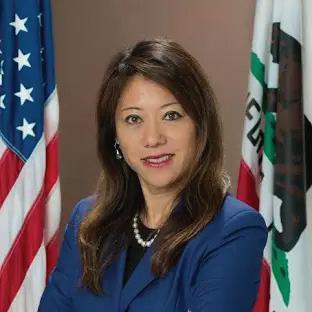
SACRAMENTO – State Treasurer Fiona Ma today
Announced $15 million in grants to support small business development programs throughout California. The grants were made through the California Investment & Innovation Program (Cal IIP) run by the California Pollution Control Financing Authority (CPCFA), which Ma chairs as state treasurer.
“Small businesses power the California economy,” said Treasurer Ma. “By distributing these funds in local communities, they allow our partners to tailor programs that meet the unique needs of those communities and help small businesses thrive.” Cal IIP grants are awarded to Community Development Financial Institutions (CDFIs) - credit unions, banks, nonprofit organizations, and other entities - which address the needs
Thursday, January 23, 2025
Lewis Family Playhouse welcomes back live action drama – the first since November 2018!
Entertainment News
Rancho Cucamonga, CA –
The award-winning play The Curious Incident of the Dog in the Night-Time opens at the Lewis Family Playhouse in Rancho Cucamonga from January 18 – February 2. Adapted from Mark Haddon's bestselling novel, this Tony Award-winning production follows 15-yearold Christopher Boone on a remarkable journey to solve the mystery of the death of a neighbor's dog, uncovering family secrets and personal triumphs along the way.
Audiences will step into the brilliant yet chaotic mind of Christopher Boone, whose extraordinary perspective
brings London to life in vivid, electrifying ways. With immersive staging, a suspenseful story, and a deeply human experience, this production will captivate audiences and feel the pulse of Christopher’s world—a place of wonder, heartbreak, and triumph.
Recently nominated for 8 San Diego Theatre Critics Circle Awards, including “Outstanding Dramatic Production,” this is one show you don’t want to miss! Secure your tickets now at www. LewisFamilyPlayhouse.com and be part of this incredible celebration of drama, discovery, and resilience.
Black DI College Athletes MUST Submit Claims For Proposed $2,8B NIL Settlement By 1/31/25
Black athletes have been essential in building Division I basketball and football into a multi-billion-dollar industry. The NCAA is on the brink of settling two cases for approximately $2.8 billion in connection with certain antitrust claims involving name, image, and likeness. Due to limited advertising specifically to Black audiences, the settlement threatens to leave some deserving Black athletes with nothing. The estimated average payment for each football and men’s basketball player is $91,000, up to $280,000. If you are, or know, a Black college athlete who played Division I sports, including basketball or football between 2016 and 2024, the athlete must register their claim either online or by mail by Jan. 31, 2025, to
help ensure the correct recovery. Football and basketball athletes from Power 5 schools and Notre Dame on full scholarship will only need to update their contact information on the website and select their method of payment. They only need to file a claim form if they believe some of their information is inaccurate and to select their method of payment. All other Division I athletes must complete a claim form by Jan. 31, 2025, in order to receive a payment. You can register your claims for both cases online at www. collegeathletecompensation. com. And this claims website contains a detailed description of the proposed settlements, including copies of certain
continued in next 2 columns
Black DI College Athletes MUST Submit Claims For Proposed $2,8B NIL Settlement By 1/31/25...continued
court orders and submissions by the parties to the case. The opt-out date is also Jan. 31, 2025. According to the claims website the following tasks are needed. Please login with your Claim ID and PIN. As an alternative, you can also login using your NCAA Eligibility Center ID. If for any reason you are unable to login with your NCAA Eligibility ID number or your Claim ID and PIN, then select “No” when asked "Do you have a Claim ID and PIN, or a NCAA Eligibility Center ID?" and submit your claim form by typing “Unknown” in the NCAA Eligibility Center ID box. Or you can contact admin@ collegeathletecompensation.com to request your Claim ID and PIN, or your NCAA Eligibility Center ID. However, if you do not have the time, consider completing your claim form by answering “No” and submitting your claim form by Jan. 31, 2025.
(Without a Claim ID and PIN or NCAA Eligibility ID number the website will not give you an estimate of your payment. You may still want to complete the claim forms so as to preserve your right to any correct or eligible payment. Including by selecting a method of payment.)
You can also submit claim forms by printing them and mailing them to the Settlement Administrator (address below) with a postmark of no later than Jan. 31, 2025.
You can access printable versions at ncco_poc_web_ house_250115.pdf and ncco_ poc_web_hubbard_250115. pdf. Answers to frequently asked questions are located at https:// collegeathletecompensation. com/house-frequently-askedquestions.aspx. If you have any questions about the claims process, please contact the claims administrator, but your claim form must be submitted by Jan. 31, 2025. College Athlete Compensation Settlement Settlement Administrator P.O. Box 301134 Los Angeles, CA 90030-1134 Phone: 1 (877) 514-1777 Email: admin@ collegeathletecompensation.com Bradford Edwards LLP is a Black owned law firm based in New York and Los Angeles. The firm specializes in corporate litigation and is a member of the National Association of Minority and Women Owned Law Firms. We are distributing this press release as a public service so that Division I athletes who wish to participate in the proposed settlement may do so. This release does not contain legal advice. The court approved lawyers representing the class of Division I athletes who are eligible for settlement payments are identified on the claims website identified above. Contact: Denver G. Edwards https://www.bradfordedwards. com
Recent California Wildfires Highlight the Need for Legal Reform...continued from page 4 revenue is $3.9 billion a year, and 825,475 lost jobs. California Citizens Against Lawsuit Abuse, the state's largest grassroots movement of small business owners pushing for legal reform to improve California's economic climate by working to address lawsuit abuse. Join with our free supporter-based grassroots movement to share your story with legislators about how a shakedown lawsuit almost forced you to close your business, cut jobs and unable to support the community. Now more than ever, the Governor and legislature must show leadership and tackle this problem once and for all. They must fix a broken system which generates exorbitant levels of damages awarded, is unpredictable in its outcomes, and may result in negative impacts through the misallocation of society’s scarce economic and human resources. Learn more by visiting californiacala.org.
What Will a Second Trump Presidency Mean for LGBTQ+ Civil Rights?...continued from page 3
other proposed legislation.
The close to 600 bills “doesn’t reflect 600 different ideas,” said Pizer. “Many legislators are introducing bills on the same subject. Why are they doing this? It’s about political theater, politics, fundraising, attentionseeking. But it’s targeting a tiny population and amongst the most vulnerable members of our society based on misinformation and indifference, if not cruelty, about the consequences.”
of communities underserved by traditional banking institutions.
CDFIs can use the grant funds for services and operations that contribute to their community development mission, including affordable housing, capital access for small businesses and individuals, and education and healthcare facilities.
The board approved Cal IIP grant awards to 63 CDFIs, for a total of $14,999,999.92.
Cal IIP highlights include:
• $9.1 million for small business support
• $5.9 million to fund community development projects and services
• $5.0 million for affordable housing programs
• $4.3 million for engaging the underbanked
The California Legislature established the Cal IIP Fund in 2022 with Senate Bill 193, which committed $50 million over several years toward grant funding. Cal IIP grants are required to be awarded by February 1. The program distributed $14.2 million in 2024. For more information about the program, visit www.treasurer.ca.gov/cpcfa/ caliip/index.asp
In Tennessee alone, 31 antiLGTBQ+ bills were introduced in 2024, with six passing. “We have to come up with ways to do more every year, and we already deploy a tactically rich approach,” said Chris Sanders, executive director of the Tennessee Equality Project, a statewide advocacy organization. Their advocacy work includes not only lobbying, bringing people to the Capitol for legislative hearings and floor votes, but also looking for other groups and professionals who will be affected by the anti-LGBTQ+ bills. “It’s really hard to run an anti-LGBTQ bill without it hitting some other area of life, and they often have spillover effects.” Health care professionals, psychologists, and counselors have been negatively impacted by some of the proposed bills as well as school funding and business recruitment. “We are happy for the bill to go down and we don’t have to be the ones at the front carrying the banner,” said Sanders.
The emphasis on coalition building has long been a strength of advocacy work among LGBTQ+ organizations. “One of most important things we know that helps us defeat these
bills is having organizing in a state year-round,” said Vivian Topping, director of advocacy and civic engagement at Equality Federation, the national partner to a network of state-based LGBTQ+ organizations. “It’s the deep relationships that our network has been able to build with folks on the ground. When we have long, strong organizing in a community, we’ve been able to beat these bills. Strong coalitions need to include not only progressive partners, but also corporate partners and folks across lines of difference.”
Advocates will draw from their years of experience working to defeat anti-LGBTQ+ state bills as well as looking back at what happened during the previous Trump administration, when “the national ACLU filed around 428 lawsuits,” said Angela Cooper, communications director at the ACLU of Kentucky. “We can expect multiple legal challenges since it’s been made clear that the [Trump] administration does not care to do things by the letter of the law. But we’re not necessarily preparing any differently than we normally would in Kentucky as a state advocacy organization. We have a Republican supermajority [in the state legislature], and we review every single bill that is filed to look for legal challenges that we might bring, work with lawmakers to try to improve bad legislation, and move forward any proactive legislation. But these attacks are designed to give us compassion fatigue. It’s exhausting, and we have to be very careful during the legislative session to take care of ourselves, to be in top form to fight all these challenges.”
With Project 2025, Republicans themselves provided useful information about what advocates can expect during the next four years. The federal policy agenda and blueprint was authored and published by officials from the first Trump administration in partnership with the Heritage Foundation, a conservative think tank. “Sometimes showing their hand can be helpful—we saw Project 2025 come out and so we didn’t have to convince anyone that this is the goal because it’s right here, in writing,” said York.
“Turning that on its head, when the playbook is open for all of us to read, it allows us to come up with new, creative, and more strategic responses to reach better outcomes.”
Advocates point to working across different issue areas as a strength of LGBTQ+ organizing.
“We have continued to prioritize and increase our collective efforts at coalition building,” said Logan Casey, director of policy research at Movement Advancement Project, a think tank. “With the attacks on transgender people’s access to medical care, there are many similarities in the attacks on access to reproductive health care. Although there has already been a lot of collaboration, there has been a growing connection between LGBTQ people and organizations and reproductive justice work to help us learn from what folks in the reproductive justice space have been dealing with for years.” The right-wing attempts to restrict access to abortion care in some states is “exactly what we are seeing with attacks on access to transgender health care.”
But advocates are also realistic about what this moment really means. “We need to face up that we are in a moment of peril and backlash,” said Minter. “Our movement is attempting to adapt to this new situation, and it’s taking us longer than I wish it did. We are not immune to the same dynamics and cycles of change that happened to other civil rights movements. It’s a common pattern in our nation’s history of making very significant progress followed by periods of severe and sometimes vicious backlash, and we are experiencing that for the first time in my lifetime and probably most people in the movement in their lifetime.”
Advocates warn against letting despair hamper efforts to fight back. “As we go into the next four years, there will be many headlines that will be scary, many proposed things that will be awful, but [we need to] remember that a headline or a tweet isn’t itself law and there’s a lot of things we can do to stop these attacks,” said Casey. “Something important to keep in mind is that there are very few executive actions or orders by themselves that can immediately change policy, and lots of what [Trump] has talked about doing will require a regulatory process. And there are steps and a process that a lot of these proposed attacks must follow. Every one of those steps is an opportunity for the movement and our allies and the general public to slow it down or stop it. Many folks across this movement and many other movements for social justice and equality have been preparing for this, and if we work together, we can meet this moment.”
Socal News
Socal News
Thursday, January 23, 2025
Buyer Beware: Your Supplements May Have Unsafe Ingredients
by Constance Brown-Riggs, MSEd, RD, CDE,CDN

Search the internet or turn on the TV and you’re likely to come across a celebrity-endorsed supplement touted to be “totally safe,” “all-natural,” or “without side effects.”
Because it’s a celebrity, we assume they’ve used the product, and we believe “it must really be safe.”
The truth is, the celebrity is only used to gain our trust and sell the product. Moreover, the product may contain ingredients that are anything but safe and may cause harmful side effects.
Today’s dietary supplements are not only vitamins and minerals: herbs and botanicals, amino acids, enzymes, and many other ingredients can be found in them.
Dietary supplements are complex products that come in a variety of forms: traditional tablets, capsules, and powders, as well as drinks and energy bars.
While many dietary supplements meet the Food and Drug Administration’s (FDA) standards for safe ingredients, some companies knowingly distribute and sell dangerous or otherwise illegal products that put consumers at risk.
Unlike drugs that must prove safety and effectiveness before marketing, dietary supplements do not require premarket review or approval by the FDA.
However, to help ensure the identity, purity, strength, and composition of dietary supplements, the FDA has established good manufacturing practices (GMPs).
These GMPs are designed to prevent the inclusion of the wrong ingredient, the addition of too much or too little of an ingredient, the possibility of contamination, and the improper packaging and labeling of a product.
To solve this problem, the FDA recently unveiled its new Dietary Supplement Ingredient Advisory List, a rapid-response tool meant to quickly alert the public when the FDA identifies ingredients that do not appear to be lawfully marketed in dietary supplements.
Consumers may wish to avoid buying and using products marketed as dietary supplements containing ingredients on this list.
How to be a smart supplement shopper
Think twice about chasing the latest headline. Sound health advice is generally based on research over time, not a single study touted by the media.
When searching for supplements on the internet, use noncommercial sites such as the National Institute of Health, Food and Drug Administration, or United States Department of Agriculture, rather than depending on information from sellers.
Learn to spot false claims. If claims sound too good to be true, they probably are. Be mindful of product claims such as “works better than medicine,” “totally safe,” or has “no side effects.”
Other red flags include claims about limited availability, offers of “no-risk, money-back guarantees,” and requirements for advance payment.
Be aware that the term “natural” doesn’t always mean “safe.”
Ask your healthcare provider if the supplement you’re considering would be safe and beneficial for you.
Always remember – safety first.
The FDA is responsible for taking action against any unsafe dietary supplement product after it reaches the market. But this means that consumers may unknowingly consume dangerous ingredients before the FDA identifies them as unsafe.
After You Apply with FEMA, Now What?
County/World News
LOS ANGELES – After you apply with FEMA for disaster assistance, you may wonder what comes next. Sometimes, FEMA may call you for more information or to give you an update. Messages from FEMA will arrive by email, phone, or text. You will know the message comes from FEMA if it is from one of the following sources:
Email from noreply-ecorr@ dhs.gov, fema-automessaging@ fema.intouchconnections.com or fema-automessaging@fema.dhs. gov. Calls from 1-800-6213362 or 1-866-863-8673.
(Sometimes FEMA may call with a recorded voice message to give you information about your application.)
Texts from 43362 or 91908. Steps you can take to help move your disaster recovery forward:
OPEN A FEMA ACCOUNT
ONLINE. A useful first step is creating your personal online account with the FEMA Disaster Assistance Center (DAC) at DisasterAssistance.gov. You will
be instructed to create a unique Personal Identification Number (PIN) for secure access to your disaster assistance application information. You may hear from FEMA within 10 days of applying or less, although the current demand for disaster assistance in Los Angeles County may briefly slow the process. Meanwhile, with your online account you can:
Track the status of your application as it is reviewed
Provide your new address if you moved or other personal information that has changed
View letters and messages sent to you by FEMA
Get details on additional documents that FEMA needs to process your assistance
Submit documents to your file
Review information you have sent FEMA and update and make corrections
For help creating or signing into your account: Visit the Login.gov Help Center.
PROVIDE ADDITIONAL
After You Apply with FEMA, Now What?... continued DOCUMENTS. Sometimes FEMA may need more information from you. There are three ways to send documents (include your name and application number):
Online in the Upload Center at DisasterAssistance.gov.
By mail to FEMA, P.O. Box 10055, Hyattsville, MD 207828055.
Faxing to 1-800-827-8112.
GATHER AND SEND OTHER INFORMATION.
FEMA may request more documents or information while your application is being reviewed, for example:
Verification of your disastercaused damage through an onsite home inspection and confirm your eligibility for a lodging program.
Verification of your identity; you may be required to submit supporting documents.
FACILITATE YOUR HOME INSPECTION. After you apply with FEMA, your request for assistance is reviewed to determine if an inspection is needed to confirm disasterrelated damage to your home and personal property. FEMA home inspections are conducted in-person or virtually, and the inspector will contact you to make an appointment. If the inspection is in-person, the FEMA inspector will show you an official photo identification
and will know your registration number; inspectors will never ask you for it (if asked, don’t provide it) There is no fee for the inspection.
BE SURE YOU UNDERSTAND FEMA’S DETERMINATION LETTER. Read your determination letter closely to understand your next steps in the process and what additional documentation may be needed. The determination letter will also provide instructions on how you can appeal FEMA's decision.
If you need additional help, call the FEMA Helpline at 1-800621-3362 or visit a Disaster Recovery Center (DRC) to learn about resources from FEMA, the state and other organizations and agencies providing disaster assistance in Los Angeles County. Two DRCs are open in Los Angeles County. Locations are:
UCLA Research Park West 10850 West Pico Blvd. Los Angeles, CA 90064
Hours of operation: 9 a.m. to 8 p.m. seven days a week.
Pasadena City College Community Education Center 3035 East Foothill Blvd. Pasadena, CA 91107
Hours of operation:
9 a.m. to 8 p.m. seven days a week.
Deadline To Submit Press Releases & Legals Is Mondays By 5pm
CalFresh customers who lost food in public safety power shutoffs may qualify for replacement benefits and hot meals

calling 1-877-410-8827.
In addition, until February 8, all CalFresh recipients can purchase hot, prepared meals with their benefits from grocery stores that accept Supplemental Nutrition Assistance Program (SNAP) benefits.
RIVERSIDE COUNTY, Calif.
-- CalFresh customers who lost food purchased with benefits due to the recent Public Safety Power Shutoffs (PSPS) have until February 5 to report the loss and receive replacement benefits.
State officials estimate that nearly 26,000 Riverside County households received more than $5.4 million in CalFresh benefits and may have lost food as of January 7, 2025 due to public safety power shutoffs intended to prevent wildfires from spreading or starting.
Affected households can report their food loss and apply for replacement benefits by visiting BenefitsCal.com, contacting their county social services office, or
“This has been a very difficult time for thousands of people, including vulnerable adults and families. Some have been without power for several days at a time, and we want to help them get back on their feet as quickly as possible,” said Sandra Bowlan, Interim Assistant Director of the Department of Public Social Services’ SelfSufficiency Division. “To our CalFresh clients in Riverside County who were impacted, please take action and reach out by February 5 to apply for replacement benefits.” CalFresh is California's largest food assistance program and offers monthly electronic benefits that can be used to purchase food at many grocery stores, farmers markets, and select online retailers like Amazon and Walmart. Residents who need food assistance but are not currently enrolled in CalFresh are encouraged to apply online at BenefitsCal.com, by calling 1-877-410-8827, or by visiting their nearest Department of Public Social Services (DPSS) office..
Four tips on addressing racism in schools
By Quintessa Williams/Word In Black
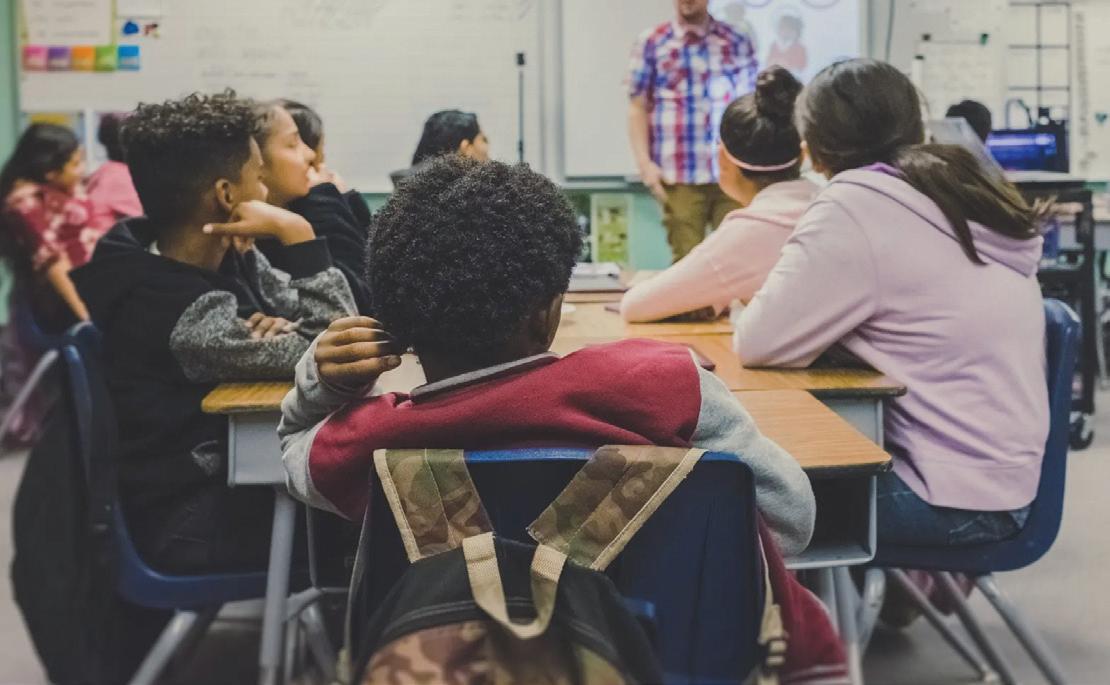
While progress has been made, racism is still an issue in the classroom. Students and their families can become better advocates by understanding all rules and procedures, and by building relationships with school staff and faculty. (Credit:) Unsplash/ Kenny Eliason)
Recent incidents of racial harassment in schools and the president elect’s re-election have intensified concerns among Black parents about their children’s safety and well-being on campus.
“As we inch closer to Jan. 20, I worry for my son and his friends who are about to graduate, a milestone we should be celebrating, but who have instead had to endure racism and harassment in spaces where they are supposed to be learning,” says a Jacksonville mother, who requested anonymity to protect her 16-year-old son’s privacy.
Her concerns aren’t unfounded.
In the hours following the president elect’s win, a wave of racist text messages targeted Black students across the nation — and her son was one of the recipients.
Of course, racial harassment and bullying aren’t new in schools. A January 2024 report from The FBI’s Uniform Crime Program found that in 2022, 828 hate crime incidents reported in schools had been motivated by racial bias, with 66 percent (547 incidents) of those cases targeting Black students. Recent data from the Centers for Disease Control and Prevention also revealed that in 2023, 45.9 percent of Black students reported experiencing racism in school, a rate notably higher than the 17.3 percent reported by White students.
And the results can be severe.
Parents in South Carolina recently filed a lawsuit after their 14-year-old daughter allegedly experienced years of bullying and harassment by students and a teacher regarding her hair and skin color. They say their daughter attempted suicide at age 12 because of the bullying and is now permanently disabled.
These challenges have become more pronounced in the current political climate. In November, just days before Election Day, Black students reported being harassed and subjected to racial slurs during a rally for the president elect at Beverly Hills High School.
“The system of education was founded on colonial principles that did not include Black people,” notes Parents of Black Children, an advocacy organization, in a recent report. It emphasizes that understanding how school systems work is crucial for Black parents who need to protect their children from racial bias.
Education experts and advocacy groups recommend several strategies:
1. Know school policies and engage proactively with staff
Familiarize yourself with school policies, such as the
code of conduct and student handbook, and learn who’s who before concerns arise.
Build relationships with teachers and any other relevant school staff, such as guidance counselors and the principal, to foster a supportive environment.
Regular communication can help avoid potential issues and ensure school teachers and other staff are aware of and responsive to your child’s needs.
The NAACP emphasized this in a 2023 report on family engagement and advocacy in the educational system.
“To change the educational landscape for Black youth, Black parents and guardians must be equitably included in all aspects of their children’s educational experiences, including curriculum, legal and transition processes, and made aware of all activities impacting their children,” it wrote.
2. Document everything
Immediately document what happened, including dates, times, locations and all individuals involved. “Dig deep. Incidents can be indicators of other problems with school culture,” advises No Place for Hate.
“Make your response priority number one, and take the key stakeholders of your school (e.g., students, families, staff, community) into account.
NPFH also encourages reporting incidents as much as possible. “Young people are often very reluctant to tell adults about these incidents because they believe reporting may make things worse. However, doing so will send a message that hateful, biased language and behaviors are unacceptable.”
3. Seek mental health support
Racial incidents in school can have a profound psychological impact on Black students. In
its 2024 report, Experiences of Racism in School and Associations with Mental Health, the CDC found that Black students who experience racism in schools exhibit a “higher prevalence of poor mental health indicators, including increased suicide risk, compared to those who did not experience racism.” It found that racism in schools can also contribute to issues, like lack of concentration in school, that often end up being misdiagnosed. Seeking out mental health support, such as with school counselors or child clinical psychologists, can help address the racial trauma students may face. “Children and even their families experience racial trauma that can lead to serious traumatic stress,” Child Trends says on their website. “It’s okay to seek the professional support you may need.”
4. Know your advocacy and legal resources
Several organizations offer guidance and resources for families navigating discrimination in school, including the NAACP Legal Defense and Educational Fund, Parents of Black Children and The Advancement Project. Other organizations like the Black Educational Advocacy Coalition, the Black Student Advocate Network, the National Education Association and the National Urban League have resources to help parents advocate for educational equity. Overall, advocates emphasize that systemic change requires both individual advocacy and collective action. And for many Black families, the work of ensuring their children’s safety and success in school will undoubtedly need to be a priority now and long after the new administration leaves office. This article was originally published by Word In Black.
County/World News
Caption: A refrigerator without power at a Riverside County business. Riverside County customers who lost food purchased with CalFresh benefits in public safety power shutoffs may qualify for replacement benefits. CalFresh customers must report food loss by Feb. 5 (Photo courtesy: Shane Reichardt, Public Information Officer II, Riverside County Emergency Management Department)
Affected CalFresh customers must report food loss by Feb.
Forest Lawn Celebrates Black History Month
With One-Night-Only Performance & Community Event
Saturday, February 1, 2025, 4:00-7:30 PM
Hall of Crucifixion-Resurrection, Forest Lawn–Glendale
LOS ANGELES, CA—Forest Lawn–Glendale celebrates Black History Month with a free, family-friendly event. The evening features a one-nightonly performance of moving and enlightening music, dance, poetry, and special-guest speeches celebrating the African American experience and culture, following a community resource fair and reception.
On Saturday, February 1, 2025, from 4:00¬¬-6:00 PM the Black History Month event will commence with a community resource and networking fair with local education, health, housing, and volunteer resources, along with complimentary refreshments and beverages. At 6:00 PM Forest Lawn, in partnership with producer Charles Lane, will present a performance with a troupe of singers and dancers, a five-piece band, as well as distinguished speakers Anita Ortega and Marie Rogers. Dr. Brenda Threatt and Michael Ellington will narrate the evening festivities.
“Forest Lawn looks forward to celebrating Black History Month with inspiring performances that honor the strength and depth of African American culture,” says Rodolfo Saenz, Forest Lawn’s Senior Vice President, Marketing. “From the stories told by the stage performers to the craftspeople and community organizations who participate in the resource fair, this event will honor all aspects the African
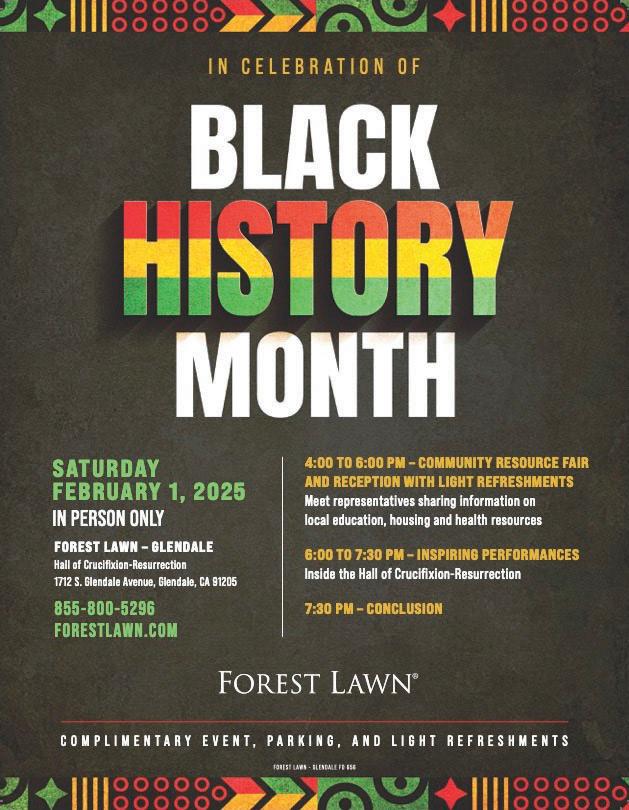
American experience.”
¬Forest Lawn’s Black History Month event takes place on Saturday, February 1, 2025, from 4:00-7:30 PM, inside the Hall of Crucifixion-Resurrection at Forest Lawn–Glendale, 1712 S. Glendale Avenue, Glendale, CA 91205. Doors open at 4:00 PM for the resource fair and pre-show reception with refreshments, music, and prizes, and continues with a 6:30 PM curtain for the performance. Seating will begin at 6:00 PM and is available on a first come, first served basis; standing room only is anticipated. Admission and parking are FREE.
Forest Lawn Museum's exhibition Narcissus Quagliata: Archetypes and Visions in Light

and Glass will also be on view in the neighboring Forest Lawn Museum until 5:00 PM. It is the first retrospective exhibition devoted to
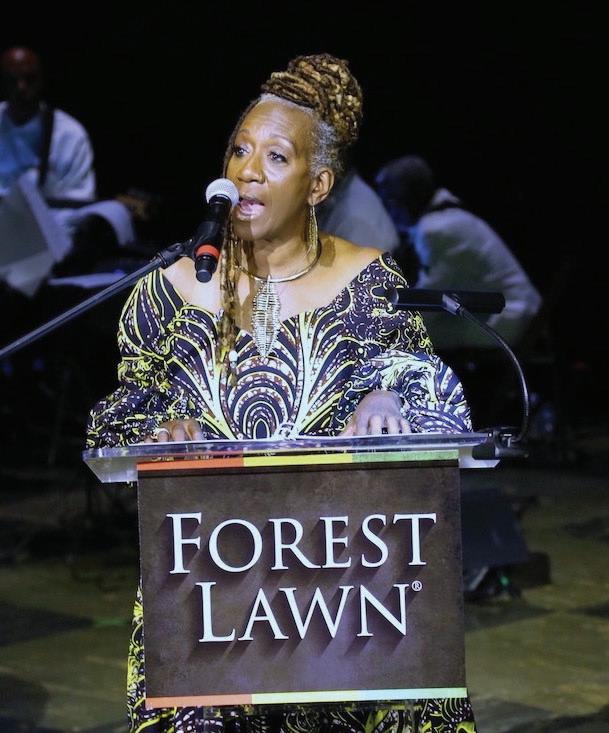
Narcissus Quagliata, one of the most influential figures in glass art from the past 50 years. From technical advances in glass fusing, to radical stylistic innovations, Quagliata has redefined what it means to be a glass artist and has been instrumental in moving stained glass beyond ecclesiastical and domestic settings and into the realms of public art and
Reflecting on Dr. Martin Luther King's Legacy - Monday, January 20, 2025

Dr. King’s legacy represents hope and resilience in the face of adversity. His ability to inspire change through peaceful means is a testament to the power of perseverance and moral conviction. We should be inspired by Dr. King's vision of a fair and just society where everyone has the opportunity to thrive. His work is a reminder that financial equity and inclusion are not just goals, but essential components of social justice. One of the most profound
lessons from Dr. King's legacy is the importance of empowerment through education. Financial literacy is a powerful tool that can help individuals and families achieve economic stability and independence. Inspired by Dr. King's dedication to education and empowerment, UFSC is committed to help our stakeholders through our programs to make informed financial decisions. By promoting financial literacy, we can help bridge the economic gap and create opportunities for all. Dr. Martin Luther King Jr.’s legacy also serves as a constant reminder that the journey toward justice and equality is ongoing. One way to honor Dr. King's legacy is to continually seek ways to embrace diversity, foster inclusive environments, and challenge the status quo. As we reflect on his legacy, let us commit to making a positive impact in our professional and personal lives, honoring the values that Dr. King so passionately championed.
avant-garde studio practices for contemporary fine art. Visit www.forestlawn.com for more information.
Image credits (left to right): Keynote speaker Dr. Stephanie Powell addresses the audience at Forest Lawn’s Black History Month event; Charles Lane performs with singers during Forest Lawn’s Black History Month event.
Californians get additional state funding for health care
SACRAMENTO, Calif. — The State of California is set to continue its efforts of getting people health insurance with enhanced benefits through Covered California that will ensure enrollees see reduced out-of-pocket costs in 2025.
Covered California was created by the state to help people get health insurance by offering financial assistance and other support. Recognizing that many people have questions about health insurance, Covered California provides local experts who can help find a plan that’s right for each person.
This new funding is available, regardless of income, when people enroll in one of the Silver-level plans through Covered California. Some of the cost-reduction benefits of these Silver plans are lower copays as well as $0 deductibles. This helps make health care costs more transparent and predictable – which ultimately means paying less when going to the doctor or getting care.
All Covered California plans include preventive care, doctor visits, emergency care, prescriptions, and more. Enrollees can choose from well-known companies like Blue Shield, Kaiser Permanente, and Anthem, providing them access to a wide range of doctors, hospitals, and specialty care.
“Recognizing that cost is still the key barrier to proper health care for too many Californians, our goal is to improve affordability for our enrollees in every aspect of their health care,” said Jessica Altman, Executive Director of Covered California. “Combined with federal support for premiums, this will be the highest level of affordability that has ever been available to our enrollees.”

T:10.5"
Dr. Martin Luther King
